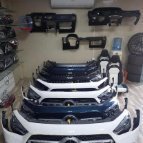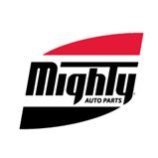-
Welcome to Auto Parts Forum
Whether you are a veteran automotive parts guru or just someone looking for some quick auto parts advice, register today and start a new topic in our forum. Registration is free and you can even sign up with social network platforms such as Facebook, X, and LinkedIn.
Structural form of engine suspension mount
-
Similar Content
-
- 7 replies
- 664 views
-
- 1 reply
- 1,485 views
-
- 0 replies
- 1,192 views
-
- 0 replies
- 1,584 views
-
-
Similar Topics
-
By Mighty Auto Parts
The post
link hidden, please login to view appeared first on link hidden, please login to view. When diagnosing engine performance complaints such as misfire symptoms, be advised that several systems and components can contribute to those symptoms. When considering single or multiple misfire codes, some checks may seem farfetched but trust me if not all are considered the symptoms can elude the most experienced technician, resulting in a misdiagnosis. When this […]
The post
link hidden, please login to view appeared first on link hidden, please login to view.
link hidden, please login to view -
By Counterman
Theory can only take you so far when formulating engine oil. Complex modeling is an important step, but it can’t duplicate the magic that happens inside the cylinder. Operating conditions, duty cycles, driver behavior—it all impacts how an engine ages. As it does, deposits form within the engine. The carbonaceous compounds that form on various engine components, including pistons, valve trains, and timing chain covers are a natural occurrence; a consequence of aging that result from the breakdown of oil components at high temperatures, particularly during the combustion process. The highest temperatures occur on the metal surfaces within the engine, where these deposits tend to adhere.
“There are some deposits that are temporary that you can wipe off with your finger, and there are others that can get very thick,” explained Dr. Michael Warholic, global technology director, Valvoline Global Operations. “The bad thing about deposits—and actually there are several bad things—are that, first of all, they insulate and you can’t get the heat out.
“They also cause friction.”
Friction is exceptionally bad, especially if you’re formulating oil. Thick deposits can clog oil passages, restricting the flow of oil to critical engine parts. This leads to inadequate lubrication, exacerbating wear and potentially causing engine failure. Traditionally the role of engine oil has been to slow down engine deposit development, but in concocting its latest engine-protecting blend, the Valvoline team stumbled upon something … surprising.
“We were trying to basically minimize deposits, engine wear, friction and heat, and oil formulation is a balance, so you have to pick and choose what you want it to do,” Warholic explained. “What we didn’t know was before the testing that it would remove and reverse the process–that is something you can’t predict by modeling. Restore and Protect removed engine deposits.
“I had never seen anything like it before, and I have eight years at Valvoline and 16 years at a company that makes the additives used in oil formulation.”
Valvoline’s Restore and Protect is a fully synthetic motor oil that aims at both older, high-mileage vehicles (restore) and new vehicles (protect). While Warholic was tight-lipped about the specific blend of additives within the oil, Valvoline has noted two proprietary technologies–Active Clean, which removes deposits and Liqui-Shield, which prevents deposit formation.
It’s not just marketing—at a recent event, Valvoline put Restore and Protect-cleaned pistons on display. Take a look:
Valvoline validates its oils through industry standard tests such as the GF-6 SP specification, which uses a Chrysler Pentastar engine to measure deposit formation. These tests provide a benchmark for oil performance, ensuring that the oil meets or exceeds industry requirements.
“Exceeds” is the key word. Warholic was quick to point out that these types of tests are merely the baseline within the oil market, not the high bar that oil manufacturers should seek to leap over.
“We want to exceed the API specifications and excel in all categories. Restore and Protect is already GF-7 capable, which is great,” he said.
Real-world testing is crucial. For instance, a Ford Mustang was subjected to extensive testing with Restore and Protect, showing significant reductions in wear and deposit formation. The testing extended to various engine components, including the timing chain cover, oil pan, and valve train, demonstrating the comprehensive benefits of the oil. The team also ran Restore and Protect in a Ford Explorer with more than 500,000. “And we also did a chassis dynamometer test where we put a vehicle on rollers basically and ran it 300,000 miles,” Warholic said. “Restore and Protect actually cleaned up the entire engine.”
For automotive aftermarket professionals, understanding the use of high-performance oils can lead to better engine health, improved engine operating efficiency, reduced maintenance costs and happy customers.
“We’re trying to maximize engine life,” Warholic said. “Vehicles are getting older. The vehicle life on the road is getting older. Vehicles may change owners and engines are going to be running longer. For us, it’s about maximizing engine performance so that you don’t lose fuel economy, you don’t lose efficiency, and you don’t break down on the highway.”
The post
link hidden, please login to view appeared first on link hidden, please login to view.
link hidden, please login to view -
By Counterman
link hidden, please login to viewreleased two new suspension bushing tool kits for on-vehicle R&I of single-wrap and double-wrap heavy-duty suspension bushings – Suspension Bushing Kit with Pump and Suspension Bushing Adapter Kit. Both tool kits replace worn-out, rusted and frozen heavy-duty suspension bushings faster and easier without risking heat or other damage by providing a 25-ton capacity, the company said. Each kit saves hours on each job by making quick work of Pivot and D-pin bushing R&I. OTC’s latest suspension bushing tool kits include:
4247-FR Suspension Bushing Kit with Pump: Includes air/hydraulic pump, 25-ton hydraulic cylinder, hose with couplers, complete puller leg/plates and adapter set for double-wrap leaf springs.
4254-FR Suspension Bushing Adapter Kit: For use with OTC service sets; 4247, 4275, 4261 or 4263 with 4106A 25-ton ram.
OTC said each suspension bushing kit features Hendrickson rear suspensions, including Primaax EX, Comfort Air and FCCC V-Ride Pivot and D-Pin suspension bushings, and freightliner rear suspensions, including double and single-wrapped FAS II Airliner rear suspension bushings. Both also include centering adapters to align tool and bushing for clean installation. Both are available through OTC distribution partners and resellers.
The post
link hidden, please login to view appeared first on link hidden, please login to view.
link hidden, please login to view -
By Counterman
Most active suspension systems come in many styles with fancy names like airmatic, dynamic or advanced. And, it doesn’t matter if it is a BMW, Mercedes or Jaguar, an active suspension must be able to react to three critical pieces of information.
First, it must act on information from the ABS and stability control system. Second, it must measure body movement. Third, it must detect the extent and rate of suspension movement. With these three pieces of information, the suspension can actively adjust the compression and rebound of the shock or strut.
Why would an engineer or automaker include this feature on a vehicle? An active dampener allows for a ride without compromise. The three inputs can be used to detect a rough road or an emergency situation where body roll could change the stability of the vehicle.
Electronic Shocks/Struts
Electronically adjustable shocks and struts use conventional mono-tube and twin-tube oil-filled dampeners. The rods, gas chambers and piston have the construction of passive units. Like a passive unit, they can fail if they leak, the gas escapes or the rods are bent. They can also wear out like a conventional unit as the oil inside breaks down and surfaces in the bore wear.
link hidden, please login to view
What makes these units unique are the valves with their variable orifices. These valves regulate the flow between the chambers on either side of the piston. The piston in some units, however, does not have any valving.
The size of the orifices controlled by electromagnetic solenoids can control the valves very quickly. The electrical connections and solenoids are typically found outside the body and act on the valves inside the unit using magnetism. The signal to the solenoid is pulse-width modulated and varies the voltage to change the size of the orifice.
The valves and solenoids can’t be serviced or separated from the shock or strut. If a problem is detected with the system, the valves go into a fail-safe position that is fixed, and the system becomes passive. The driver is then alerted with a message or light on the instrument cluster or message center.
Most systems will perform a circuit check when the system wakes up. This typically involves sending a signal to fully open and close the valve. If the system detects an open, short or a voltage outside of the specifications, it will set a code.
Measuring Wheel Movement
Ride-height sensors not only measure the position of the suspension, but also the rate of movement. They are supplied with a voltage of around 5 volts. The signal voltage is changed as a magnet moves past a coil. Most sensors have three wires – ground, power and signal.
Internally, it is difficult to damage one of these sensors. Externally, however, the linkage that connects the sensor to the suspension arm can be damaged. Additionally, the connector can be damaged and cause a short or open that sets a code. If one of these sensors is replaced, it must be calibrated after it is installed.
Ride-height sensors are sometimes called suspension-position or wheel-displacement sensors. The data from the sensor is used to measure the movement of the suspension. By knowing how far and fast the suspension is moving, the module can use the information to determine the size of the orifice in the dampener to control compression and rebound. These sensors should be calibrated if a sensor is replaced, a module is reprogrammed or if the battery dies.
Measuring Body Movement
Accelerometers mounted to the body measure changes in the ride. These accelerometers are typically mounted to the strut towers. These sensors output information as gravitational forces, or “G-force,” to a module. Changes in body roll due to cornering will produce lower G-force than a pothole would.
Information from the accelerometers is coupled with data from the ride-height sensor, steering sensor and other inputs by a computer processor in a module. The module can determine if the vehicle is going around a corner or traveling down a bumpy road. With this datastream, the valving inside the dampener can be adjusted in milliseconds for the best control and ride quality.
The accelerometers on the body differ from vehicle to vehicle. Some manufacturers mount the sensors under the headlights, on strut towers and near the taillights. More sophisticated systems use more than two accelerometers mounted in various locations.
link hidden, please login to view Control Module
The control module for the electronic dampeners needs more than the movement of the wheels and body to determine the correct settings for the dampeners. The module uses and shares information with the anti-lock braking system, engine control module and instrument cluster. This information is typically shared on the high-speed CAN serial data bus. On some BMW 7 Series models, the information is shared on the fiber-optic Flex Ray bus.
With all this information, the module can do some amazing things with the adjustable dampeners. Problems like nosedive under braking, torque steer and understeer on FWD vehicles can be minimized. If the vehicle has air ride, the volume and pressure inside the air springs can also be tuned along with the valving in the dampeners to optimize ride quality and control.
Most active suspension systems will perform a circuit check when the system wakes up. The system will send 5 to 12 volts to the actuators and ride height sensors. The system is also looking at the resistance in the circuit, and the amount of voltage dropped. If the system detects an open, short or voltage outside of the specifications, it will set a code. Next, the control module will fully open and close the valves in the struts. If the system does not detect any irregularities, the system will go into an active mode.
Looking for these self-diagnostic signals can be performed using a meter. You may have to use a bypass harness or back probe the connector. If the system detects any problems, the system will go into a passive mode.
Sometimes servicing an active suspension is like rebuilding an engine with a new crankshaft and reusing the old bearings and valve springs. When a new active strut is reassembled with the old and tired spring and strut plate, the results can be less than desirable.
Upper strut mounts and bearings can be hammered to death. The upper strut mount essentially supports the vehicle weight and counters both braking and acceleration torque. Most mounts are sandwiches of rubber, metal and bearings. Over time, the rubber can lose its ability to isolate the suspension from the body. Bearings can also seize and bind, causing the vehicle to have steering problems.
Look up the ride height specifications and measure ride height front and rear, and on both sides of the vehicle. If ride height is less than specifications, the problem is most likely one or more weak springs that should be replaced. Springs should typically be replaced in pairs to maintain the same ride height side-to-side.
Weak springs also are more likely to fail. The springs on many late-model vehicles are thinner to reduce weight and have an outer plastic coating to protect the metal from corrosion. If this outer coating is cracked or damaged, corrosion can form a hot spot that eats into the spring, weakens it and eventually causes the spring to break.
The post
link hidden, please login to view appeared first on link hidden, please login to view.
link hidden, please login to view






Recommended Posts
Join the conversation
You can post now and register later. If you have an account, sign in now to post with your account.
Note: Your post will require moderator approval before it will be visible.